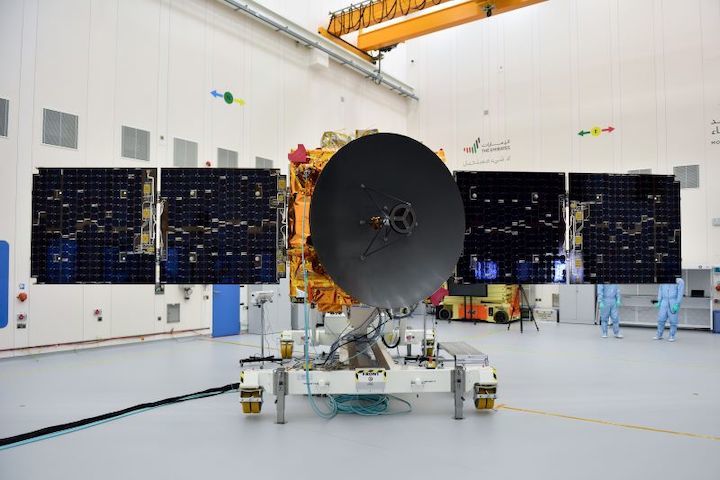25.05.2020

The UAE’s Mars Hope Probe is scheduled to launch to the red planet on July 15, 2020, the Emirates Mars Mission has announced.
The first interplanetary exploration undertaken by an Arab nation, the probe will undertake a 495,000,000km journey to Mars. It is anticipated to enter Mars’ orbit in February 2021.
The countdown to the launch begins after the probe’s transfer from the UAE to Japan.
The launch is now scheduled for Wednesday, July 15, 2020 at 12.51am UAE time (5.51am local time) from Japan’s Tanegashima Space Centre, via the Mitsubishi Heavy Industries (MHI H2A) platform.
The date represents the opening of the launch window for the Emirates Mars Mission, which extends to the August 13, a statement said.
The MHI H2A platform was chosen due to its “high success rates in launching spacecraft and satellites globally”. The UAE has also previously collaborated with MHI to successfully launch the Khalifa Sat satellite.
Testing
Since its arrival in Japan, the Hope Probe has undergone detailed processing operations for the launch.
Completed over 50 working days, the process entails filling the fuel tank with about 700kgs of hydrogen fuel and ensuring there are no leaks. It also requires testing the communication and control devices, moving the probe to the launch pad, installing the probe on the rocket that will carry it to space, and ensuring the probe batteries are fully charged.
A team of Emirati nationals is leading the operation and supervising every aspect of the probe’s preparation for its launch.
Sarah Bint Youssef Al-Amiri, minister of State for Advanced Sciences and Emirates Mars Mission deputy project manager, said: “The challenges overcome by the Hope Probe team amidst the global pandemic confirm the UAE mission’s commitment to achieve the impossible.
“Our team continues to work diligently to ensure the mission’s success, and we look forward to collectively celebrate the arrival of the probe on Mars in February 2021 – also coinciding with our 50-year anniversary.”
Long journey
The journey of moving the Hope Probe from Dubai to the launch site on Tanegashima Island in Japan spanned more than 83 hours and underwent three major stages.
The first phase involved the preparation and transportation of the probe from the Mohammed Bin Rashid Space Center to Dubai’s Al Maktoum International Airport, which spanned 16 hours. The second stage saw the probe’s 11-hour transfer from Al Maktoum International Airport in Dubai to Nagoya Airport in Japan and included loading the probe and its supporting equipment into the giant ‘Antonov 12’ plane – the largest cargo plane in the world.
The third stage was the probe’s transfer from Nagoya Airport to the launch site on Tanegashima Island. It included the probe’s safe landing and land transportation to Shimama Harbor, and its final transfer by sea to Tanegashima Island.
In light of Covid-19 concerns, strict health procedures were followed to ensure the health and safety of the teams involved. A separate team also travelled earlier and underwent the mandatory quarantine procedures in Japan prior to receiving the probe upon arrival to oversee its transportation to the launch station.
The Hope probe project is being implemented by the Mohammed bin Rashid Space Centre, with the UAE Space Agency funding and supervising procedures.
Quelle: Gulf Business
+++
UAE completes transfer of the Hope Probe to launchpad in Japan
The Hope probe’s mission to Mars will start in mid-July 2020 from the Tanegashima Space Center, and is expected to reach the Red Planet’s orbit in the first quarter of 2021
The UAE Space Agency and the Mohammed Bin Rashid Space Centre (MBRSC) confirmed the completion of the Hope probe’s transfer to its launch site at the space station on Tanegashima Island in Japan, despite the Covid-19 related challenges.
The transfer of the probe from the Mohammed Bin Rashid Space Center to Al Maktoum International Airport took 12 hours via a special truck that included sensitive scientific equipment.
Meanwhile, the world’s largest cargo plane transported the Hope probe from Dubai to Japan on an 11-hour journey. The team also monitored the intensity of the air bumps where severe vibrations would affect the structure of the probe. The team accompanying the probe delivered it to the team in Japan upon arrival at Nagoya Airport.
Finally, the probe took over 44 hours over land and sea from its arrival at Nagoya Airport in Japan to the departure station on Tanegashima Island.
Dr. Ahmed bin Abdullah Hamid Belhoul Al Falasi, Minister of State for Higher Education and Advanced Skills and chairman of the UAE Space Agency said: “We would like to take this opportunity to extend our highest gratitude and appreciation to the wise leadership of the UAE for their continuous and unlimited support on this project to explore Mars and the national team of young women and men dedicated to this project.”
Sara Al Amiri, Minister of State for Advanced Sciences, Deputy Project Manager of EMM, pointed out that the Emirates Mars Mission is part of the UAE’s accelerated developmental journey to further establish itself as a leader in space science and exploration.
“Today, we must celebrate the scientific achievement of our engineers, scientists and technicians. This milestone will become an integral part of the UAE’s history that we collectively take pride in. This project will become the largest scientific addition to the Arab World’s notable achievements in the space and sciences industry,” she added.
The Hope probe is a national project that reflects the UAE’s vision to build an Emirati space program, to strengthen international cooperation and partnership with a view to finding solutions to global challenges. The Hope probe’s mission to Mars will start in mid-July 2020 from the Tanegashima Space Center using the Mitsubishi Heavy Industries (MHI H2A) platform and is expected to reach the Red Planet’s orbit in the first quarter (February) of the year 2021.
Quelle: Gulf Business
